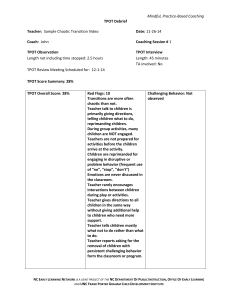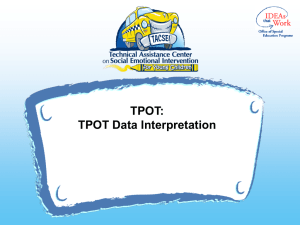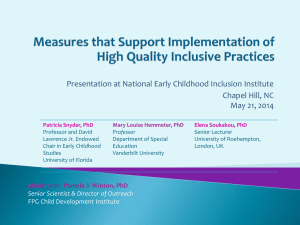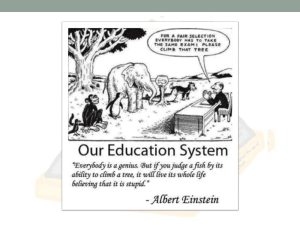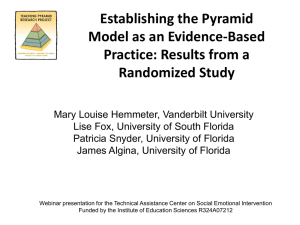Teacher Skills and Strategies Checklist-TPOT
advertisement
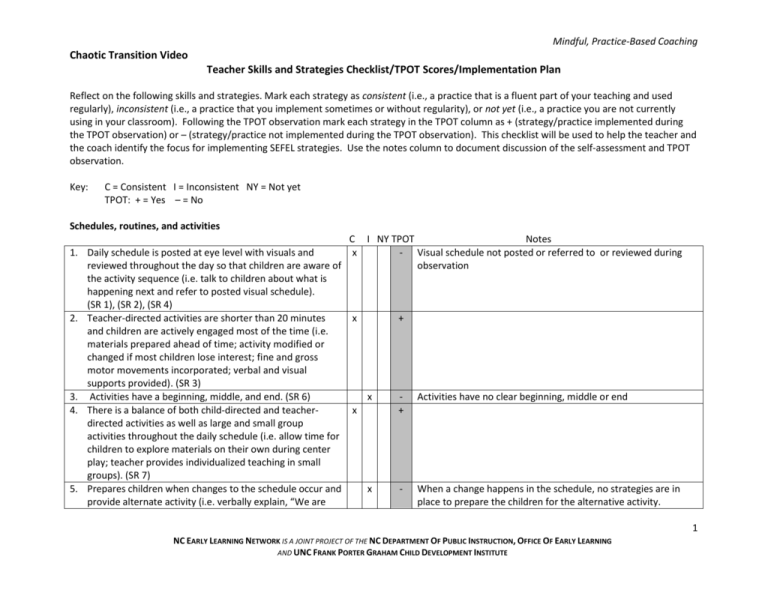
Mindful, Practice-Based Coaching Chaotic Transition Video Teacher Skills and Strategies Checklist/TPOT Scores/Implementation Plan Reflect on the following skills and strategies. Mark each strategy as consistent (i.e., a practice that is a fluent part of your teaching and used regularly), inconsistent (i.e., a practice that you implement sometimes or without regularity), or not yet (i.e., a practice you are not currently using in your classroom). Following the TPOT observation mark each strategy in the TPOT column as + (strategy/practice implemented during the TPOT observation) or – (strategy/practice not implemented during the TPOT observation). This checklist will be used to help the teacher and the coach identify the focus for implementing SEFEL strategies. Use the notes column to document discussion of the self-assessment and TPOT observation. Key: C = Consistent I = Inconsistent NY = Not yet TPOT: + = Yes – = No Schedules, routines, and activities 1. 2. 3. 4. 5. C I NY TPOT Notes Daily schedule is posted at eye level with visuals and x - Visual schedule not posted or referred to or reviewed during reviewed throughout the day so that children are aware of observation the activity sequence (i.e. talk to children about what is happening next and refer to posted visual schedule). (SR 1), (SR 2), (SR 4) Teacher-directed activities are shorter than 20 minutes x + and children are actively engaged most of the time (i.e. materials prepared ahead of time; activity modified or changed if most children lose interest; fine and gross motor movements incorporated; verbal and visual supports provided). (SR 3) Activities have a beginning, middle, and end. (SR 6) x - Activities have no clear beginning, middle or end There is a balance of both child-directed and teacherx + directed activities as well as large and small group activities throughout the daily schedule (i.e. allow time for children to explore materials on their own during center play; teacher provides individualized teaching in small groups). (SR 7) Prepares children when changes to the schedule occur and x - When a change happens in the schedule, no strategies are in provide alternate activity (i.e. verbally explain, “We are place to prepare the children for the alternative activity. 1 NC EARLY LEARNING NETWORK IS A JOINT PROJECT OF THE NC DEPARTMENT OF PUBLIC INSTRUCTION, OFFICE OF EARLY LEARNING AND UNC FRANK PORTER GRAHAM CHILD DEVELOPMENT INSTITUTE Mindful, Practice-Based Coaching Chaotic Transition Video Teacher Skills and Strategies Checklist/TPOT Scores/Implementation Plan not going to be able to go outside today because it is raining, so we are going to go to the gym,” and place a stop sign over outside time on schedule). (SR 8) 6. Redirects children or modifies activities when children are withdrawn or off-task to more productive activities (i.e. use rhymes such as “Hocus, pocus, everybody focus” to bring attention back to teacher/activity). (SR 9) 7. Children needing extra support use an individual schedule or cues. (SR 10) - Teacher redirects students by saying, “No! Stop!” - Individual students who needed extra support with materials or visual items did not receive assistance to transition x x Transitions 1. Teaches children the steps and behavior expectations of transitions and provide lots of opportunity to practice (i.e. review steps for washing hands during circle time; post individualized picture cues). (TR 1), TR 4) 2. Provides individual and/or whole class warnings prior to transitions (i.e. give a verbal 5 minute warning and set a timer. “When the timer goes off it is time to clean up,” five fingers countdown). (TR 2) 3. Uses transition strategies that ensure children are actively engaged in the transition (i.e. sing songs while moving between activities; provide books/games that reinforce academic concepts while waiting). (TR 3) 4. Individualizes directions to start the transition. (TR 6) 5. Guides individual children who need help transitioning. (TR 7) 6. Gives children activities to fill wait time during transitions. (TR 8) C I NY TPOT Notes x - Opportunities to practice /teach behavior expectations during transition were missed x - No individual or whole group transition strategies were used. x - Transition to outside play was chaotic and students did not appear to understand the procedures x - x - Individual directions were not provided to students prior to transition Individual students were not guided to independence during transition Students did not have activities to do during transition x - 2 NC EARLY LEARNING NETWORK IS A JOINT PROJECT OF THE NC DEPARTMENT OF PUBLIC INSTRUCTION, OFFICE OF EARLY LEARNING AND UNC FRANK PORTER GRAHAM CHILD DEVELOPMENT INSTITUTE Mindful, Practice-Based Coaching Chaotic Transition Video Teacher Skills and Strategies Checklist/TPOT Scores/Implementation Plan Supportive conversations 1. 2. 3. 4. 5. 6. 7. 8. 9. C I NY TPOT Notes Acknowledges children’s communication. (SC 1) x - Children attempt to get teacher attention but are not acknowledged Uses children’s names. (SC 2) x + Has brief conversations with children (3 turns). (SC 3) x + Joins in play and has brief conversations about play. (SC 4) x + Uses positive and supportive tone. (SC 5) x + Responds to children’s ideas with questions and x - Teacher did not respond to children’s ideas with questions and comments. (SC 6) comments Joins in play to expand interaction with other children. x - Teacher joined children’s play but did not use opportunities to (SC 8) expand interactions with other children Has extended conversations about children’s ideas (4+ x - See SC 6 above turns). (SC 9) Uses alternative strategies to communicate with children x - Several children were unable to communicate with other who need support. (SC 10) children but no alternative strategies were used Engagement 1. Guides children to choose activities and engage. (ENG 1) 2. Uses developmentally appropriate activities. (ENG 2) 3. Communicates at eye level with the children almost all of the time (i.e. in close proximity to children and actively engages in activities with them). (ENG 3) 4. Structures large group so children are actively engaged. (ENG 4) 5. Guides children to select activities or use materials to promote engagement (i.e. get the attention of a child who is not cleaning by inserting his or her name into the C I NY TPOT Notes x + x + x - Many students were not actively engaged. Directions were not clear and specific for activities x - Several students were not engaged in large group activities x - Engagement was evident in small group activities but not large group activities however children did not share materials or take turns with each other. 3 NC EARLY LEARNING NETWORK IS A JOINT PROJECT OF THE NC DEPARTMENT OF PUBLIC INSTRUCTION, OFFICE OF EARLY LEARNING AND UNC FRANK PORTER GRAHAM CHILD DEVELOPMENT INSTITUTE Mindful, Practice-Based Coaching Chaotic Transition Video Teacher Skills and Strategies Checklist/TPOT Scores/Implementation Plan Clean-up Song, provide a visual cue to prompt them to pick up toys). (ENG 5) 6. Provides choices and options when possible during large group, small group, and center times. (ENG 6) 7. Provides positive descriptive feedback and/or choices when challenging behavior is occurring in the classroom (i.e. “I see you are having a hard time sitting in circle. Do you need a chair, or would you like to go to our safe space?”). (ENG 8) 8. Redirects children or modifies activity when children are withdrawn or off-task to more productive activities (i.e. use rhymes such as “Hocus, pocus, everybody focus” to bring attention back to teacher/activity). (ENG 9) x - x - No positive descriptive feedback was noted. Teacher said, “No! and Stop!” to stop inappropriate behavior during transition. Teacher tells children what not to do instead of what to do. - Teacher physically moves children who are not lining up correctly during transition to outside play. x Providing directions 1. Uses directions that are short, simple and specific (i.e. “Use your walking feet”). (PD 1) 2. Tells children what to do rather than what not to do. (PD 2) 3. Describes activity expectations before beginning activity. (PD 4) 4. Redirects children or modifies activity when children are withdrawn or off-task to more productive activities (i.e. use rhymes such as “Hocus, pocus, everybody focus” to bring attention back to teacher/activity). (PD 5) 5. Checks in with children to make sure they understand the directions (i.e. ask children to repeat directions or give the directions to another child) cue to prompt them to pick up toys). (PD 6) 6. Individualizes directions for children who need more C I NY TPOT Notes x - Directions are multi step and vague x - Teacher tells children, “NO! and “Stop!” but not what to do x - Expectations are not discussed before beginning the transition x - Children who had difficulty with transition were not provided modified directions or materials to increase engagement x - Children were not asked to repeat directions in order to assure they understood what to do. x - Directions were not modified for children needing more support 4 NC EARLY LEARNING NETWORK IS A JOINT PROJECT OF THE NC DEPARTMENT OF PUBLIC INSTRUCTION, OFFICE OF EARLY LEARNING AND UNC FRANK PORTER GRAHAM CHILD DEVELOPMENT INSTITUTE Mindful, Practice-Based Coaching Chaotic Transition Video Teacher Skills and Strategies Checklist/TPOT Scores/Implementation Plan support (i.e. When a child does not respond to a whole group direction such as “Get your coats and line up” the teacher repeats the direction in smaller steps – “Get your coat. [pause] Line up.”). (PD 7) Collaborative teaming C 1. All adults engage with children during activities/routines. (CT 1) 2. Adults use positive tone with each other. (CT 2) 3. Adults know what to do in the classroom. (CT 3) 4. All adults entering room engage with children. (CT 4) 5. All interactions between adults are related to the classroom. (CT 5) 6. Roles are shared between adults. (CT 6) 7. All adults provide instruction. (CT 7) 8. Children initiate positive interactions with all class adults. (CT 8) I NY TPOT Notes x - Teacher Assistant spends most of her time cleaning, hand washing and diapering children x + x - Teacher assistant does not interact with students in center or group times x - Speech therapist does not engage with other children when visiting the classroom x + x x x - See number CT 1 and number CT 3 See number CT 1 and Number CT 3 Children do not interact with the Teacher Assistant independently Behavior expectations 1. Establishes and displays no more than five rules for a given area (circle or center area, hallways, outdoor play areas, bathrooms, etc.), connecting them throughout the day to the school’s or LEA’s behavior expectations. (TBE 1) 2. Reviews and facilitates learning of posted behavior expectations and rules with children prior to and during individual-, small-, large-group activities, and during transitions. (TBE 2). C I NY TPOT x + x - Notes Review of rules and expectations only occurs first thing in the morning at morning group 5 NC EARLY LEARNING NETWORK IS A JOINT PROJECT OF THE NC DEPARTMENT OF PUBLIC INSTRUCTION, OFFICE OF EARLY LEARNING AND UNC FRANK PORTER GRAHAM CHILD DEVELOPMENT INSTITUTE Mindful, Practice-Based Coaching Chaotic Transition Video Teacher Skills and Strategies Checklist/TPOT Scores/Implementation Plan 3. Gives whole-class reminders of behavior expectations. (TBE 3) 4. Gives individual children reminders of expectations during small group or play. (TBE 4) 5. Comments on positive behavior, referring to the rules. (TBE 5) 6. Uses naturally occurring opportunities to facilitate discussions which will allow children to think critically about the importance of following behavior expectations and rules in the school environment. (TBE 7) x - x - x - x - Children are given whole group reminders to line up but no expectations as to the expected behavior No reminders for individual children about behavior expectations No connection between the behavior to the rules, why do we need to line up orderly etc. Opportunities throughout the day such as line up time are not used to discuss the importance of the behavior expectations. Positive descriptive feedback C 1. Gives positive descriptive feedback for transitioning. (TR 5) 2. Gives positive descriptive feedback for skills, behaviors, and abilities. (SC 7) 3. Gives positive descriptive feedback for engagement. (ENG 7) 4. Gives positive descriptive feedback for following directions. (PD 3) 5. Adults give each other positive descriptive feedback about their classroom work. (CT 8) 6. Gives positive descriptive feedback, referring to the behavior expectations, throughout day. (TBE 6) 7. Gives positive descriptive feedback for using social skills and appropriately expressing emotions (TSC 6) 8. Gives positive descriptive feedback for children who are working together, helping each other or engaging in friendship behaviors. (FR 2) 9. Gives positive feedback and publicly recognize children who have been “good problem solvers.” (TPS 6) I NY TPOT Notes x - Teacher says, “No! Stop!” does not use positive descriptive feedback x - No descriptive feedback around skills, behaviors, and abilities x - Positive feedback on behaviors was not descriptive x - Feedback was positive but not descriptive, for following directions Adults do not comment on children’s work to each other, positively No positive, descriptive feedback on behavior expectations noted No positive, descriptive feedback on using social skills or expressing emotions was noted. Positive feedback was not noted for children working together, helping each other in centers, large or small group times. x - x - x - x - x - Feedback and recognition of children who used problem solving skills was not noted 6 NC EARLY LEARNING NETWORK IS A JOINT PROJECT OF THE NC DEPARTMENT OF PUBLIC INSTRUCTION, OFFICE OF EARLY LEARNING AND UNC FRANK PORTER GRAHAM CHILD DEVELOPMENT INSTITUTE Mindful, Practice-Based Coaching Chaotic Transition Video Teacher Skills and Strategies Checklist/TPOT Scores/Implementation Plan Teaching social-emotional competencies 1. Uses naturally occurring opportunities to teach social emotional skills throughout the day. (TSC 1) 2. Provides children with planned opportunities to practice friendship skills (i.e. working together, role playing). (TSC 2) 3. Uses a variety of strategies to teach social emotional skills. (TSC 3) 4. Uses group settings (both large and small) to teach social emotional skills. (TSE 4) 5. Uses and models expected behaviors while describing the behavior(TSC 5) 6. Facilitates children’s reflection on their use of social emotional skills. (TSC 7) 7. Gives positive descriptive feedback for using social skills and appropriately expressing emotions (TSC 6) 8. Individualizes social emotional skills instruction for specific children. (TSC 8) C I NY TPOT Notes x - Opportunities throughout the day are not utilized to teach social skills, including transition time x + x - x - x - x - x - x - Children are not provided with a variety of strategies for social emotional skills Teacher uses large group time but not small group time to teach social skills Teacher does not model expected behaviors while describing the behavior Students are not given an opportunity to reflect upon their use of social emotional skills Teacher does not provide descriptive, positive feedback around expressing emotions No attempts to individualize instruction around social skills for specific children Teaching friendship skills 1. Encourages children to play together. (FR 1) 2. Uses multiple strategies and materials (discussion, puppets, books) in group activities to teach friendship skills (helping others, taking turns, organizing play). (FR 3) 3. Provides children with planned opportunities to practice friendship skills (i.e. working together, role playing). (FR 4) C x x x I NY TPOT - Notes Multiple strategies not observed for teaching friendship skills + 7 NC EARLY LEARNING NETWORK IS A JOINT PROJECT OF THE NC DEPARTMENT OF PUBLIC INSTRUCTION, OFFICE OF EARLY LEARNING AND UNC FRANK PORTER GRAHAM CHILD DEVELOPMENT INSTITUTE Mindful, Practice-Based Coaching Chaotic Transition Video Teacher Skills and Strategies Checklist/TPOT Scores/Implementation Plan 4. Explicitly teaches how to initiate and respond to peers. (FR 5) 5. Provides individualized assistance to help children maintain interactions. (FR 6) 6. Supports peers to help friends learn skills (peer buddies, play routines and roles). (FR 7) 7. Models friendship skills in interactions with children and other adults. (FR 8) 8. Facilitates children’s reflection on use of friendship skills. (FR 9) 9. Individualizes social emotional skills instruction for specific children. (TSC 8) x - x - x - x - x - x - No attempt to teach children helping others, turn taking, organizing play skills Several students did not initiate and respond to peers appropriately during small group play, had difficulty turn taking and entering play with others. Teacher said stop and share. No support for children to help each other through peer buddy assignments, or center assignments Teacher does not model friendship skills in interactions with children or other adults No opportunity for students to reflect on friendship skills No individualization of social emotional instruction for individual students was observed Teaching children to express emotions 1. Uses a variety of strategies to teach emotion words. (TEE 1) 2. Teaches multiple positive and multiple negative emotions. (TEE 2) 3. Include instruction using a variety of materials (books, puppets, games etc.)and strategies to recognize feelings in self and others in the daily lesson plan. (TEE 3) 4. Labels and helps children talk about emotions. (TEE 4) C I NY TPOT x + x + x - No evidence of using a variety of materials and strategies to recognize feelings in self and others x - x - Children who are upset or hurt are not encouraged to express their feelings A child who was angry did not use calm down strategies to get himself under control Teacher did not assist the student with steps to calm down No attempts by the teacher to model or label her own feelings of frustration when the children had difficulty lining up Children do not comfort a child who is hurt Individualization around teaching emotions and using a variety 5. Provides children with strategies to use when they are angry in order to calm down. (TEE 5) 6. Models or labels own emotions or ways to express emotions. (TEE 6) 7. Teaches children to respond to others’ emotions. (TEE 7) 8. Individualizes emotion instruction; procedures and Notes x - x x - 8 NC EARLY LEARNING NETWORK IS A JOINT PROJECT OF THE NC DEPARTMENT OF PUBLIC INSTRUCTION, OFFICE OF EARLY LEARNING AND UNC FRANK PORTER GRAHAM CHILD DEVELOPMENT INSTITUTE Mindful, Practice-Based Coaching Chaotic Transition Video Teacher Skills and Strategies Checklist/TPOT Scores/Implementation Plan materials vary for specific child. (TEE 8) of materials was not observed. Teaching problem solving 1. Supports children as they work through the problemsolving process in naturally occurring situations. (TPS 1) 2. Engages children in generating solutions to common classroom problems. (TPS 2) 3. Explicitly teaches problem-solving steps using visuals. (TPS 3) 4. Provides visual reminders about problem-solving steps and possible solutions. (TPS 4) 5. Notes problem situations and use those as examples during group situations to talk about how to problem solve. (TPS 5) 6. Facilitates children’s reflection on use of problem solving skills. (TPS 7) 7. Individualizes instruction and use different procedures and materials to teach problem solving based on children’s individual needs. (TPS 8) 8. Uses problem solving in interactions with children and model problem-solving steps (TPS 9) C I NY TPOT Notes x - Problem solving steps not displayed or evident in classroom x - x - Students are not engaged in generating solutions to problems that occur in the classroom No problem solving visuals are evident in the classroom x - No visual reminders available in classroom x - Problems are not discussed and used to talk about solutions x - Students are not given an opportunity to reflect on use of problem solving steps Individualization around teaching problem solving steps and individualization of materials for problem solving was not observed x x - - Opportunities for interactions with children and opportunities to practice and model problem solving steps are not addressed Challenging behavior interventions 1. Initiates functional assessment process (refers to team, starts taking data). (PCB 1) 2. Collects data on behavior’s function and shares with team. (PCB 2) 3. Gives the team classroom strategies for behavior plan. (PCB 3) C I NY TPOT x + x + x - Notes Teacher is not familiar with a behavior plan 9 NC EARLY LEARNING NETWORK IS A JOINT PROJECT OF THE NC DEPARTMENT OF PUBLIC INSTRUCTION, OFFICE OF EARLY LEARNING AND UNC FRANK PORTER GRAHAM CHILD DEVELOPMENT INSTITUTE Mindful, Practice-Based Coaching Chaotic Transition Video Teacher Skills and Strategies Checklist/TPOT Scores/Implementation Plan 4. Implements behavior plan strategies and components. (PCB 4) 5. Collects data to monitor child’s behavior plan progress. (PCB 5) x - x - Teacher is not familiar with the strategies and components of behavior plan Teacher does not feel she should be responsible for collecting more data on students Connecting with families 1. Offers families ongoing opportunities to visit classroom. (COM 1) 2. Sends home periodic info from school or teacher. (COM 2) 3. Represents families in the classroom (family photos). (COM 3) 4. Provides at least monthly info to parents about classroom. (COM 4) 5. Sends home regular celebrations of child’s accomplishments. (COM 5) 6. Individualizes communication to family based on knowledge of family situation. (COM 6) 7. Uses different methods of communication with different families. (COM 7) 8. Offers bi-directional communication systems (families have a space to write back). (COM 8) C I NY TPOT x + x + x + x + x + x + x + x + Notes Supporting family pyramid use 1. Provides social-emotional information to families. (INF 1) 2. Provides families with community resources for socialemotional development AND challenging behavior. (INF 2) 3. Sends home strategies for families on S.E. skills or prosocial behavior. (INF 3) C x x I NY TPOT + + x - Notes Teacher has difficulty identifying what skills to target for families 10 NC EARLY LEARNING NETWORK IS A JOINT PROJECT OF THE NC DEPARTMENT OF PUBLIC INSTRUCTION, OFFICE OF EARLY LEARNING AND UNC FRANK PORTER GRAHAM CHILD DEVELOPMENT INSTITUTE Mindful, Practice-Based Coaching Chaotic Transition Video Teacher Skills and Strategies Checklist/TPOT Scores/Implementation Plan 4. Works with families to develop home strategies to address challenging behavior. (INF 4) 5. Supports parents in taking behavior data at home (observation notes, ABC data). (INF 5) 6. Involves families on team to develop behavior plans. (INF 6) 7. Individualizes to support families with specific social concerns about their child. (INF 7) x - Teacher has difficulty identifying what skills to target for families x - Teacher does not understand data collection for behaviors - Teacher does not see the role of the family in a behavior plan for school Teacher has limited knowledge of resources for the family x x - Material has been adapted from the following sources: Instructional Practices Checklists; http://modules.nceln.fpg.unc.edu/foundations/module-intro Center for Social Emotional Foundations of Early Learning; http://csefel.vanderbilt.edu Teaching Pyramid Observation Tool (TPOT), (Lise Fox, 2014) 11 NC EARLY LEARNING NETWORK IS A JOINT PROJECT OF THE NC DEPARTMENT OF PUBLIC INSTRUCTION, OFFICE OF EARLY LEARNING AND UNC FRANK PORTER GRAHAM CHILD DEVELOPMENT INSTITUTE
